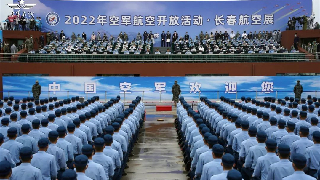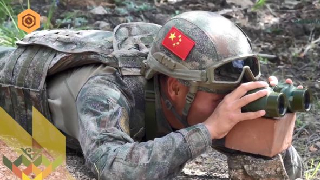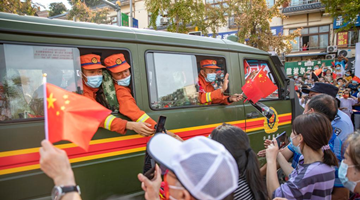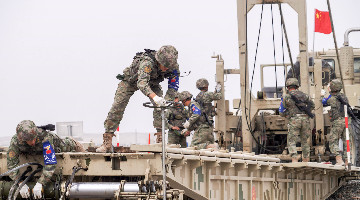By Hafijur Rahman

Editor's note:Hafijur Rahman is a columnist and Security and Strategic analyst, working in a prominent Strategic Studies Center in Bangladesh. The article reflects the author's opinions and not necessarily the views of CGTN.
On August 16, the South Korean capital Seoul turned into a massive demonstration scene, with thousands of South Korean citizens taking to the street to protest against the U.S. military presence in their country. The demonstration was triggered by the maximally provocative "Ulchi Freedom Shield"- the largest tri-service joint military drills around the Democratic People's Republic of Korea (the DPRK) since 2017, involving thousands of troops as well as live-fire exercises.
The demonstration, with thousands chanting "this land is not a U.S. war base," took a direct aim at the heart of U.S. policy in Korea. But in an utter display of hypocrisy, not a single word about the protest appeared in any Western media, whereas almost any information regarding the DPRK, be it fake news, rumor, or even the slightest change in the DPRK leader's health, becomes fodder for the mainstream Western media and get wall-to-wall coverage.
However, here my point is not to draw up the details of the demonstration or the Western media hypocrisy. Rather it is to focus on whether the South Korean people's very demands raised during the demonstration make any sense, given their long-standing resentments and outrage against the U.S. military presence in the country and potentially destabilizing frequent shows of force.
Once inadvertently entered into the region and stationed as a deterrent to its cold war rival, the former Soviet Union, the United States Forces Korea (USFK), with around 28,500 U.S. troops, remains stationed in South Korea for more than seven decades since the armistice brought an end to the Korean War unofficially. Though over the decades, regional circumstance has undergone sizeable changes that bear no relation to reality today concerning the unceasing U.S. military presence in the region, resulting in the following inevitable problems.
Blocking diplomatic window
Once highly fraught with historical acrimony and the Cold War split, regional inter-state relations have gradually evolved into an extraordinary shape, and continue to cater to regional peace and progress. Besides, East Asian countries are uniquely positioned to employ diplomacy as an all-resolving tool for any regional dispute, given their shared history, geographical proximity, demographic affinity, and ethnic commonality. It is the external imperial affront, directed out of maintaining hegemonic dominance, which is causing the disputes to be dragging on.

To be true, there are some long-standing disrupting factors to the regional stability, notably concerning the DPRK's nuclear and missile activities which the U.S. has constantly been pointing out to drive its military deluge across the region. But, given the ever-comprehensive brutal sanctions on the DPRK and continuous U.S. military bellicosity around it, the question is – How much diplomacy has so far been given a try to end this loggerhead, except for the unilateral attempt to enforce the DPRK's denuclearization?
It is widely argued that "it was U.S. hostility that compelled the DPRK to seek the bomb in the first place– that things would have turned out differently had the United States normalized relations, lifted sanctions, concluded a peace treaty, and pulled its troops out of South Korea." Even, it is widely believed that the U.S. is not quite sincere to end the DPRK's nuclear issue, rather wants to drive a wedge between inter-Korean centering on the dispute, with a larger aim to build up its alliance against China as a part of its grand strategy to contain China.
Hollowness of deterrence
The U.S. has long reasoned its military presence and incessant lethal military build-up in and around South Korea as a deterrent to the DPRK nuclear threat. But, the current conflict in Ukraine has demonstrated how dangerously this type of deterrent effort and rampant militarization other than diplomacy along this line could turn out. It is now broadly acknowledged, one not acclaimed in biased Western media, that it is NATO's very eastward expansion, military build-up across its frontiers, and subsequent Russian insecurity which are primarily responsible for the current conflagration.
Similarly, given the current reality of the East-Asian region, where the countries are more connected on multidimensional fronts with larger collective stakes than ever before and capable enough to end any inter-state disputes through diplomacy, such external militaristic muscle flexing with hegemonic self-interests would only lead the so-called deterrent efforts to regional destabilization.
It is now no way for the U.S. military presence in South Korea to be seen as a generous endeavor to safeguard South Korea or its so-called democratic values. Rather whole things along this line have gradually been morphing into a potentially disastrous U.S. broader strategy to contain China. Pushing hard on the countries by the U.S. toward nuclearization, the Quadrilateral Security Dialogue (Quad), AUKUS, and so forth testify truth to that proposition.
It is high time to stand against this disastrous militarized status quo, escalating further day by day in the way one sign in the demonstration reads: "No war rehearsal, No U.S." and "No Korea-U.S.-Japan military cooperation."











